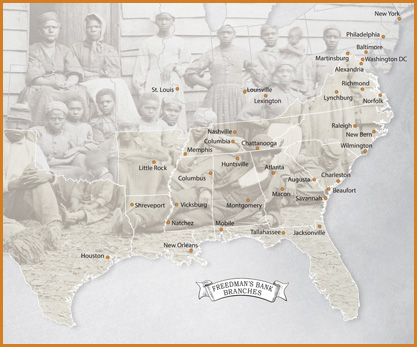Life of the Bank
The Freedman’s Bank opened in New York on April 4, 1865. At first, it was very successful. Branches were soon opened in cities with large African American populations, mostly in the South. Within a few years, the bank had 19 branches and 23,000 depositors. Almost all were African Americans. Many African American churches and institutions, such as Howard University, had accounts as well. Ultimately, 37 branches were established and over 100,000 people had opened accounts.
Most deposits at the bank were small – less than $60. People could open an account with as little as 5 cents, and accounts with at least $1 earned interest. People would often put their money in the bank during the summer and autumn and take it out in the winter and spring, when their supplies would be running low. People also used their savings to buy bigger items such as homes, land, farm animals, and tools.
African Americans were also hired to work at the bank. By 1874, nearly half of the bank’s employees were African American. Most were cashiers – the top officials at the branches. Otherwise they were assistant cashiers, clerks, or messengers.
Even though the Freedman’s Bank’s business grew, it struggled financially. Maintaining so many branches was costly, and the bank’s source of income was small. It made a profit by investing depositors’ money in government bonds, but these bonds didn’t pay a high rate of interest. The Freeman’s Bank survived with help from the Freemen’s Bureau.
Next: The Demise of Freedman's Bank

